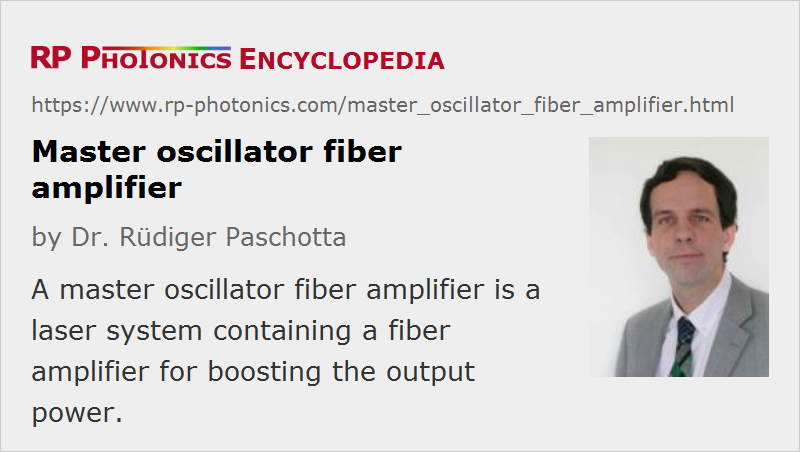Master Oscillator Fiber Amplifier
Acronym: MOFA or MOPFA
Definition: a laser system containing a fiber amplifier for boosting the output power
More general term: master oscillator power amplifier
Categories: fiber optics and waveguides, lasers, optical amplifiers
How to cite the article; suggest additional literature
Author: Dr. Rüdiger Paschotta
The term master oscillator fiber amplifier (MOFA, MOPFA, or fiber MOPA) is a variation of the term master oscillator power amplifier (MOPA), meaning a system where the power amplifier is a fiber amplifier. The latter is usually a cladding-pumped high-power amplifier, often based on an ytterbium-doped fiber. The main attractions of such fiber-based power amplifiers are:
- A high output power can be achieved with a high power efficiency.
- The cooling system can be relatively simple.
- The beam quality can be high; it is often close to diffraction-limited.
- The gain can easily be as high as tens of decibels. For comparison, most bulk amplifiers, particularly those with high average output power, have a much lower gain.

However, the use of fibers also has disadvantages:
- Various kinds of fiber nonlinearities can make it difficult to reach very high peak powers and pulse energies in pulsed systems. For example, a few millijoules of pulse energy in a nanosecond pulse system are already considered high for a fiber device, whereas bulk lasers can provide much higher energies. In single-frequency systems, stimulated Brillouin scattering (SBS) can severely limit the output power.
- Due to the high gain, fiber amplifiers are relatively sensitive to back-reflections e.g. from a workpiece. At high power levels, it is not easy to use a Faraday isolator for solving this problem.
- The polarization state is often undefined and unstable, unless polarization-maintaining fibers are used.
It can be attractive to use a gain-switched laser diode as seed laser for a fiber MOPA. Such devices compete with Q-switched lasers, e.g. for application in laser marking. Their advantages partly lie in their flexibility concerning output formats: it is easy to modify not only the pulse repetition rate but also the pulse duration and shape, and of the course the pulse energy.
A special aspect of MOFAs is that the saturation power even of a large mode area double-clad fiber is low compared with the typical output power. Therefore, the power extraction can be as efficient as in a fiber laser, even for relatively low seed powers.
Questions and Comments from Users
Here you can submit questions and comments. As far as they get accepted by the author, they will appear above this paragraph together with the author’s answer. The author will decide on acceptance based on certain criteria. Essentially, the issue must be of sufficiently broad interest.
Please do not enter personal data here; we would otherwise delete it soon. (See also our privacy declaration.) If you wish to receive personal feedback or consultancy from the author, please contact him e.g. via e-mail.
By submitting the information, you give your consent to the potential publication of your inputs on our website according to our rules. (If you later retract your consent, we will delete those inputs.) As your inputs are first reviewed by the author, they may be published with some delay.
See also: master oscillator power amplifier, optical amplifiers, fiber amplifiers, high-power fiber lasers and amplifiers, The Photonics Spotlight 2008-09-24, The Photonics Spotlight 2008-12-16
and other articles in the categories fiber optics and waveguides, lasers, optical amplifiers
 |




If you like this page, please share the link with your friends and colleagues, e.g. via social media:
These sharing buttons are implemented in a privacy-friendly way!